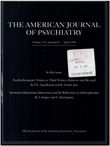Six-month stability of psychiatric diagnoses in first-admission patients with psychosis
Abstract
OBJECTIVE: The short-term diagnostic stability of schizophrenic and other psychotic disorders was examined in first-admission patients, with attention to the principal reasons for diagnostic change. METHOD: Hospitalized first-admission patients (N = 278) participating in an epidemiologic study were interviewed at baseline and after 6 months with the Structured Clinical Interview for DSM-III-R. A best estimate diagnosis was made at both time points with the use of all available sources of information. Reasons for changes in diagnosis were determined by two psychiatrists. RESULTS: Affective psychosis and schizophrenic disorders were relatively stable broad diagnostic categories over the 6-month period, with 86.5%-88.9% of the patients remaining in the same category, although findings for specific diagnoses within these categories ranged from 61.5% to 85.7%. The groups with unknown and nonspecific diagnoses showed less stability; the diagnoses of more than one-third of these patients remained unknown or nonspecific at the 6-month evaluation. If the 6-month diagnoses are used as the research standard, somewhat lower percentages of patients received the same diagnoses at baseline. Forty-three percent of the changes in diagnosis were attributed to the clinical course of illness; the rest were attributed to the diagnostic process itself. CONCLUSIONS: A longitudinal diagnostic assessment based on multiple sources of information is crucial for categorizing first-admission psychotic patients, particularly those who do not initially fit into a DSM-III-R category. The short-term stability of a diagnosis is a function of multiple factors, including the changing clinical picture, additional sources of information, and new interpretations of original data.
Access content
To read the fulltext, please use one of the options below to sign in or purchase access.- Personal login
- Institutional Login
- Sign in via OpenAthens
- Register for access
-
Please login/register if you wish to pair your device and check access availability.
Not a subscriber?
PsychiatryOnline subscription options offer access to the DSM-5 library, books, journals, CME, and patient resources. This all-in-one virtual library provides psychiatrists and mental health professionals with key resources for diagnosis, treatment, research, and professional development.
Need more help? PsychiatryOnline Customer Service may be reached by emailing [email protected] or by calling 800-368-5777 (in the U.S.) or 703-907-7322 (outside the U.S.).



